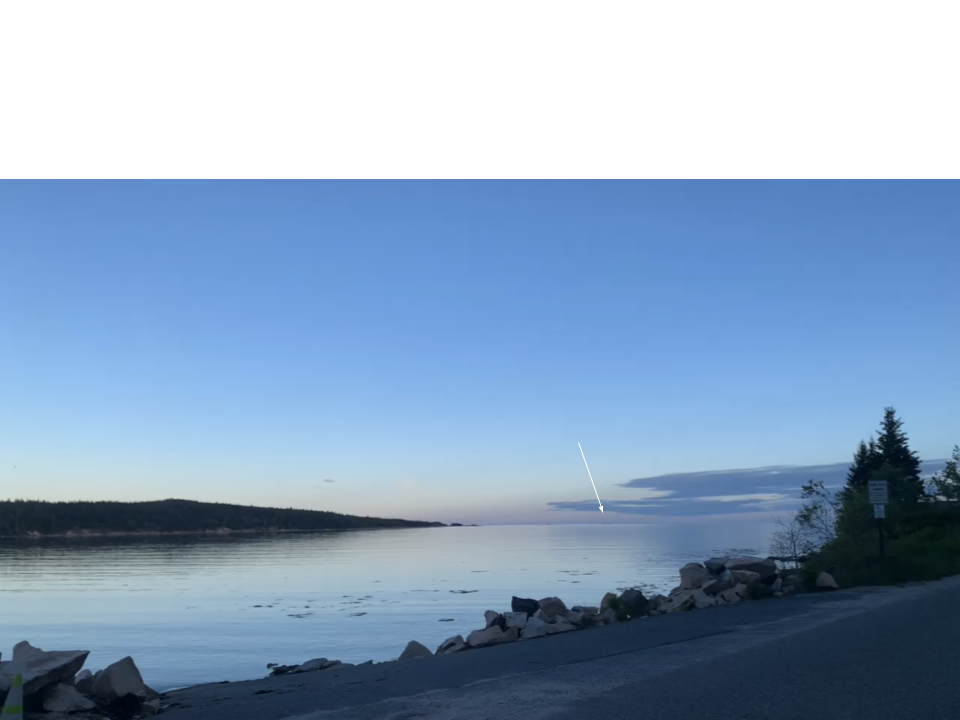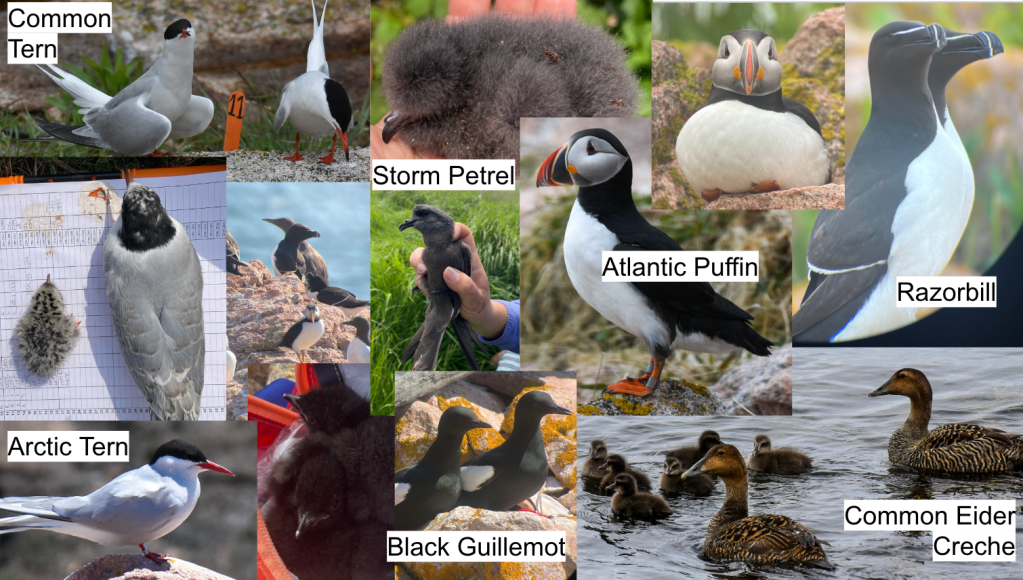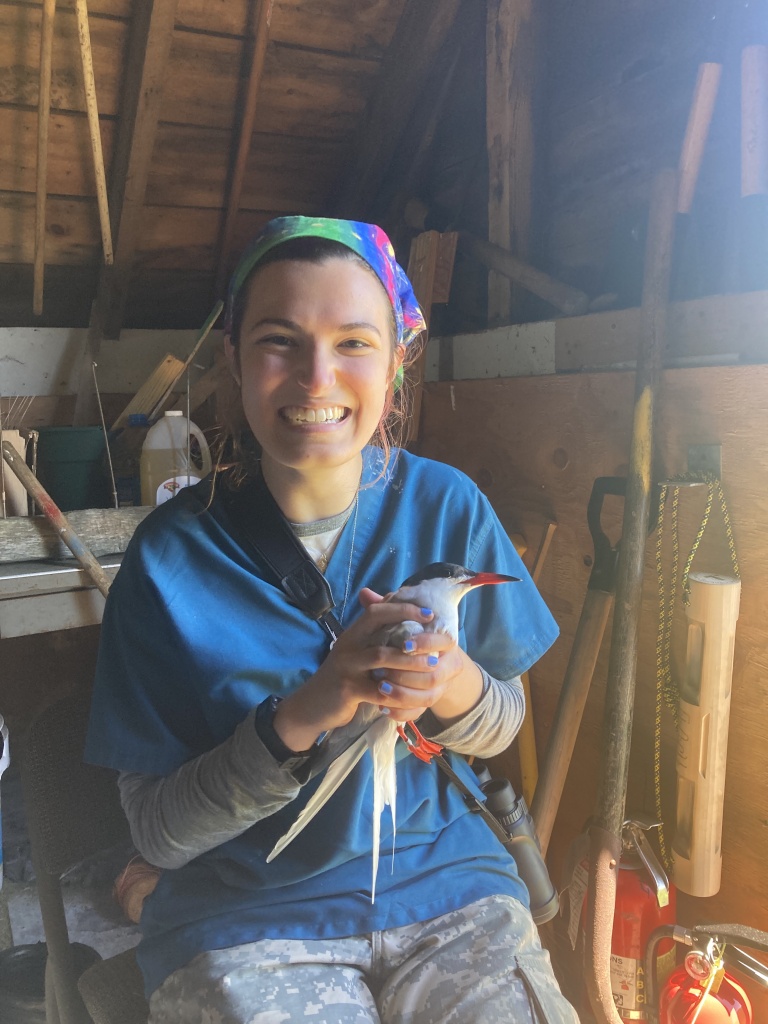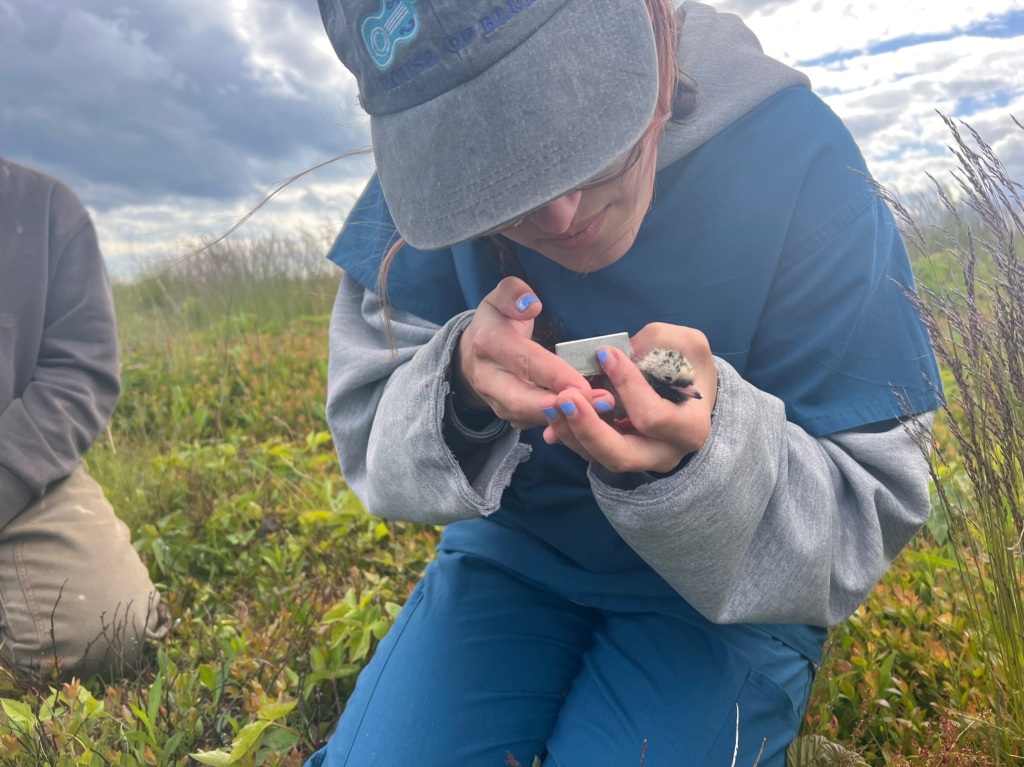Hello, all! I am Leah Nath and have been working in the Gownaris lab this summer on Petit Manan Island, Maine. Our crew is made up of Tasha Gownaris (ES Professor), Jocie Little (’25), Logan Becker (’25), and a technician (Devin Leal) and supervisor hired by USFWS (Amanda McFarland). The island, where we are staying for all of June and July, is a forty-minute boat ride from the mainland. USFWS staff from the mainland bring us our food and drinking water weekly. The island is very small and doesn’t have any trees, but it does have one house that we are staying in, a boathouse, two sheds, and the second-tallest lighthouse in Maine!

My first view of the island from the mainland
Our beautiful view from the island at sunset
Our primary tasks involve monitoring and management of the different bird species on the island, which mainly entails tracking predation attempts by laughing gulls and peregrine falcons and collecting productivity and diet data. We track the number of nests and adults of the seabirds, the dates that chicks hatch, the linear growth rate of chicks, the success of fledging, and feeding rates and prey items throughout the season. In our full census of the island, we found a total of 1,072 tern nests, meaning there are at least 2,144 terns on the island, 35% of which are Arctic terns Sterna paradisaea (a state threatened species) and 65% common terns Sterna hirundo. The terns this year are doing an excellent job of parenting by incubating their eggs and keeping them safe by hitting us over the head and pooping on us constantly; we are proud of their commitment even despite being their targets. We also have one of four Atlantic puffin Fratercula arctica (a state threatened species) colonies in North America. Unfortunately the puffins have needed to work hard to rebuild its burrows, which were nearly all destroyed over the past winter due to extreme storms – another effect of climate change. Besides terns and puffins, we also collect data on black guillemots Cepphus grylle, razorbills Alca torda (state threatened), common eiders Somateria mollissima, common murres Uria aalge, and Leach’s storm petrels Hydrobates leucorhous.

Summary of some of the species living on the island; photos taken by various crew members over the past two years.

Handling and banding my first bird (a common tern)!

A common tern posing on Jocie Little’s head
First Arctic tern chick, which hatched on 06/13. Arctic terns fledge their nest at around 21 days old.


Handling and measuring my first tern chick!
Trophic Ecology Data
In addition to the regular monitoring on the island, we are here to collect data on the trophic ecology of terns and alcids to better understand how these species are responding to rapid climate change in the region. We collect trophic ecology data using three approaches: GPS tagging, provisioning watches, and stable isotope analysis.
GPS TAGGING
We have now finished tern GPS tagging, which involves trapping Arctic and common terns with treadle and box net traps to attach a GPS tag and harness, attach lifetime serial bands, and collect measurement data. The GPS data will help to inform where the terns are traveling, so as to protect them from the impact of proposed offshore wind farms in upcoming years and to track the impact of global warming on these birds. Terns are typically expected to forage within 20-30 km of their nests, but last year’s tagging data found that they were traveling as far as 120 km to forage for the most nutritious fish available (hake and herring). We will also attach tags to puffins, guillemots, and storm petrels to look at these questions across species; Linda Welch, the Supervisory Wildlife Biologist at the Fish and Wildlife Service, will be coming to the island to help with tagging for these species, as the alcid tags are attached with suturing rather than a harness.
Professor Tasha Gownaris attaching a GPS tag to a tern on Metinic Rock using a leg-loop harness.

Tasha and Logan Becker (’25) attaching a tern tag using a leg-loop harness on PMI
PROVISIONING WATCHES
The Gulf of Maine is warming faster than nearly any other place on Earth, so understanding the individual and colony-wide changes these birds are making can provide a better understanding of adaptability to potentially similar changes that may be seen in other places around the world soon. Hake and herring, the tern’s ideal prey, are swimming farther offshore to find colder ocean temperatures. While some of the birds are foraging farther distances to find these fish, others are choosing to feed more often with invertebrates and other prey closer to the island. To understand what the birds are eating, where they are getting it from, and how it is impacting their growth, we will pair the GPS data to provisioning stints (three hour sections of watching certain nests each day) to compare foraging locations with feeding choices. As a group, our team has begun working on a paper to analyze provisioning data over time to see how the terns have changed their behaviors in the last twenty years. We will also be establishing additional provisioning stints for puffin burrows next week. For puffins, we take photos of the birds flying in with fish and identify the fish back in the lab.

My first provisioning stint of the season!
ISOTOPE ANALYSIS
Along with our tagging and provisioning data, we have been collecting different types of samples to send for stable isotope analysis. These samples have included/will include egg membranes (pre-breeding diet) and blood samples (blood cells for diet from the last 2-3 weeks, plasma for diet from the last 2-3 days). By looking at the samples in conjunction with the tagging and provisioning data, we will be able to gather a robust sense of what the chicks are being fed and from where, as well as how this diet is impacting their growth development.
With a month left to go, I cannot wait to keep learning and interacting with these birds. Soon, I will begin learning to handle puffins and guillemots, as well as take blood samples from tern chicks. I also am particularly excited to monitor the development of one burrow which has a puffin egg and razorbill egg together! I hope to be able to learn as much as I possibly can and be able to add to the work that this team and Dr. Tasha Gownaris have been building up so impressively for the past few years!
